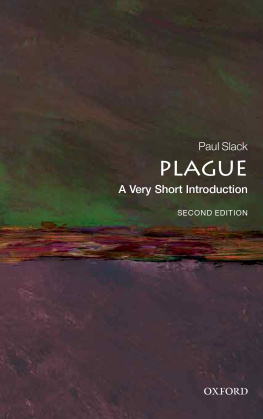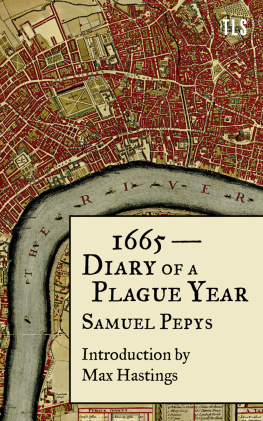The Plague of1665:
DanielDefoes
Journal of thePlague Year
and othercontemporary accounts
EmmaLaybourn
Published byEmma Laybourn at Smashwords 2020
Commentary andthis adaptation of Defoe: Copyright 2020 Emma Laybourn
The Plague of1665:
Daniel DefoesJournal of the Plague Year
and othercontemporary accounts
*
Introduction
This book aimsto give an overview of the Great Plague of London in 1665,outlining its pathology and history, and to gather and comparevarious accounts of it that were written at the time.
Chief amongthese accounts is Daniel Defoes A Journal of the PlagueYear (which, though written some years later, drew heavily oncontemporary sources); this famous book is presented here inabridged form.
The otherwriters examined are diarists notably Pepys who lived throughthe plague, doctors who practised in London at the time, andwould-be doctors who proposed their own remedies. These authors arerepresented by extracts and summaries of their work. One sermon isalso included, as a particularly interesting example of itsgenre.
Finally, theAppendix contains the full text of the Lord Mayors Orders for thecity in 1665.
Table ofContents
General
Narrative
Diarists
Medical andscientific works
Religiousworks
Appendix
The Plague:the disease and its history
The highlydangerous disease known as plague is caused by the bacteriaYersinia pestis, which normally lives on small mammals suchas rats and other rodents. The bacteria causes three forms of thedisease: bubonic (the most common form), septicaemic andpneumonic.
Plague can betransmitted in several ways. Fleas which bite an infected animalmay spread the bubonic version of the disease to the next animalsthey bite, including humans. Humans can also catch plague fromcontact with infected body tissue or fluids, and by inhalingdroplets from a person suffering from the pneumonic form of thedisease.
After theinitial infection, there is an incubation period of between one andseven days. Patients then begin to suffer from fever, an achingbody, nausea and vomiting, and general weakness. The lymph nodes inthe groin, armpits and neck may become inflamed, swollen andpainful: these swellings are known as buboes. The bubonic form ofplague is fatal in between 30% and 60% of people.
In historicepidemics of plagues, smaller spots, pustules and carbuncles werealso recorded elsewhere on the victims bodies and were frequentlyreferred to as the tokens (i.e. signs of the disease). Althoughthese tokens were commonly seen by doctors in 1665 (for example,William Boghurst, whose list of symptoms appears later in thisebook) they seem to be largely absent from modern cases of thedisease.
The bubonicform of plague may progress to infect the lungs, causing pneumonicplague. This causes difficulty in breathing and can rapidly lead torespiratory failure and shock. Pneumonic plague is likely to befatal if untreated.
A furthercomplication is septicaemic plague, which occurs when the bacteriamultiply in the bloodstream. This causes bleeding from the mouthand other orifices, shock, and gangrene (the blackening and deathof body tissue) in the patients extremities. It frequently causesdeath on the same day that symptoms appear.
*
All types ofplague are treatable nowadays with antibiotics, as long asdiagnosis is early enough. The World Health Organisation website https://www.who.int/health-topics/plague lists recent occurrences as well as other information about plague.It has become a very rare disease with only a few hundred cases ayear worldwide.
However, thiswas not always so. Plague has ravaged human populations many timesthrough the centuries, and has evidently been around for at leastfive thousand years. Researchers have found a form of plague DNA ina five thousand year old tomb in Sweden, and have suggested that itmutated from earlier infections in European settlements wheresanitation was poor. As wheeled transport spread trade throughoutEurope, the plague could well have been spread along with it.( https://www.livescience.com/64246-ancient-plague-swedish-tomb.html )
By the time ofthe Greek historian Herodotus, plague had become a well-knowndisease. Book 6 of his Histories mentions how, in the year494 BCE or thereabouts, a group of a hundred youths were sent fromChios to Delphi, of whom ninety-eight were struck down by plague.In 430 BCE plague spread to Athens from north Africa; and the RomanEmpire was afflicted by an epidemic in 250 to 270 CE.
The Plague ofJustinian (542546 CE) was the first great pandemic in whichplague spread across the globe, arriving at Constantinople in 542CE and killing thousands a day there, before advancing across theMiddle East to Iran.
In thefourteenth century a second great pandemic ravaged China, India andRussia; Italian traders carried the disease to Europe in 1347. Thiswas the outbreak known as The Black Death, which arrived inBritain in 1348. It may have killed over half of Europespopulation, and worldwide may have had almost 100 million victims(according to estimated world population figures from the UScensus: https://www.census.gov/data/tables/time-series/demo/international-programs/historical-est-worldpop.html ).
After the BlackDeath, outbreaks of the disease in Britain continued regularly,with major epidemics occurring in London every thirty years or so.There were serious epidemics in1563, 1593, 1625 and 1665.
The outbreak of1563 may have killed one-quarter to one-third of the cityspopulation perhaps 18,000 people. In August of that year itcaused over a thousand deaths a week, and forced Queen Elizabeth toleave London and set up her court at Windsor.
About the samenumber of people are thought to have died in the epidemic of 1592.In 1625, when London was again visited (a term often used for aplace that fell victim to plague,) it seems to have been with lessdevastating effect than previously. However, in 1665 the plague wasto return in full virulence.
*
The main hostfor the plague in Britain is thought to have been the black rat,which passed it on to humans via rat fleas. English epidemicstended to start in spring, heighten through summer and decline withthe colder weather, when rat fleas often hibernate, or in severeweather may even die. Outbreaks were usually worst in towns andcities with their higher density of population, especially in theover-crowded and unsanitary areas inhabited by the poor.
The outbreaksin the sixteenth and seventeenth centuries were all part of thesecond pandemic, which lasted for several centuries as plaguecontinued to reappear sporadically throughout Europe, especiallyaround the Mediterranean. The Great Plague of Seville, forinstance, beginning in 1647, wiped out a quarter of that Spanishcitys population.
Londons mostnotorious outbreak, in 1665, became known as the Great Plague ofLondon, and also killed about a quarter of the population. It wasnot in fact as severe as the Black Death of the fourteenth century,but it was better documented, and was the last such major outbreakof the disease in England.
However,globally plague did not go away. In 1738 a further epidemicafflicted Eastern Europe; and what is now known as the thirdpandemic began in China in 1855. This final pandemic caused manymillions of deaths in India and China, and continued in smalleroutbreaks throughout the world into the early twentieth century.Only with the discovery of antibiotics has plague become a minorcause of sickness and death, instead of a major and greatly fearedone.
The GreatPlague of 1665 in England: an outline
The 1665epidemic may have been started by flea-infested bales of cottonshipped over to London from Amsterdam, or by ships from Rotterdamwhich landed at Yarmouth. Certainly that town on Englands eastcoast suffered several deaths from the plague in November 1664.













